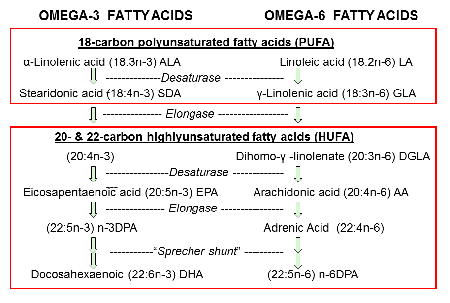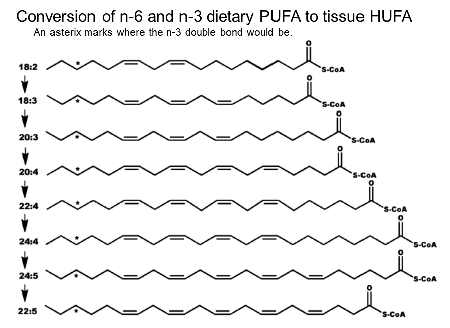Metabolizing PUFA to HUFA
 Metabolism of omega-3 and omega-6 EFA changes the chain length of 18-carbon polyunsaturated fatty acids (PUFA) that are abundant in foods into long chain 20- and 22-carbon highly unsaturated fatty acids (HUFA) that accumulate in cell membranes. The number notations (e.g., 18:3n-3) indicate the carbons in the chain and the number of double bonds in the n-3 or n-6 structures.
Metabolism of omega-3 and omega-6 EFA changes the chain length of 18-carbon polyunsaturated fatty acids (PUFA) that are abundant in foods into long chain 20- and 22-carbon highly unsaturated fatty acids (HUFA) that accumulate in cell membranes. The number notations (e.g., 18:3n-3) indicate the carbons in the chain and the number of double bonds in the n-3 or n-6 structures.
The HUFA balance in tissues is linked to n-3 and n-6 nutrient intakes. The balance affects the intensity of many physiological actions that convert the HUFA into active hormone-like eicosanoids that control our physiology.
The balance of n-3 & n-6 HUFA chains is a health risk assessment value.
 These structures of the different omega-6 EFA show how the fatty acid chain grows longer and more double bonds are added during metabolism of linoleic acid, the most abundant essential fatty acid in American foods.
These structures of the different omega-6 EFA show how the fatty acid chain grows longer and more double bonds are added during metabolism of linoleic acid, the most abundant essential fatty acid in American foods.
The asterisk shows where the additional double bond occurs in the corresponding, competing omega-3 EFA that are formed from the major omega-3 nutrient in plants, alpha-linolenic acid (18:3n-3). Foods from the oceans, like fish and shellfish, contain appreciable amounts of omega-3 nutrients that compete with n-6 nutrients during these metabolic steps and affect HUFA balance.
